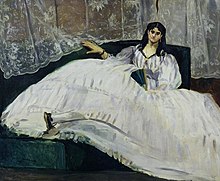This article needs additional citations for verification. (July 2016) |
Jeanne Duval (French pronunciation: [ʒan dyval]; c. 1820 – after 1862) was a Haitian-born actress and dancer of mixed French and West African ancestry. For 20 years, she was the muse of French poet and art critic Charles Baudelaire. They met in 1842 when Duval left Haiti for France, and the two remained together, albeit stormily, for the next two decades. Duval is said to have been the woman whom Baudelaire loved most in his life[1] after his mother. She was born in Haiti on an unknown date, sometime around 1820.
Jeanne Duval | |
|---|---|
 Jeanne Duval as drawn by Charles Baudelaire. | |
| Born | Jeanne Duval, Jeanne Prosper or Jeanne Lemer c. 1820 Jacmel, Haiti |
| Died | 1862–1870 (unknown; aged between 41 and 50) Paris, France |
| Partner | Charles Baudelaire |
Poems of Baudelaire's that are dedicated to Duval or pay her homage include "Le balcon" (The Balcony), "Parfum exotique" (Exotic Perfume), "La chevelure" (The Hair), "Sed non satiata" (Yet she is not satisfied), "Le serpent qui danse" (The Dancing Serpent), and "Une charogne" (A Carcass).[2]
Baudelaire called her "mistress of mistresses" and his "Vénus Noire" ("Black Venus"), and it is believed that Duval symbolized to him the dangerous beauty, sexuality, and mystery of a Creole woman in mid-19th century France.[3] She lived at 6, rue de la Femme-sans-tête (Street of the Headless Woman) on the Ile Saint-Louis, near the Hôtel Pimodan.[4]

Édouard Manet, a friend of Baudelaire, painted Duval in his 1862 painting Baudelaire's Mistress, Reclining.[5] She was, by this time, going blind.[6]
Duval may have died of syphilis as early as 1862, five years before Baudelaire, who also died of syphilis.[7] Other sources claim that Duval survived Baudelaire.[8] Nadar claimed to have seen Duval, last, in 1870—by this time she was on crutches, suffering heavily from syphilis.[9]
Popular culture
editJeanne Duval serves as a main character in Caribbean author Nalo Hopkinson's The Salt Roads, a work of historic fiction,[10] and in the title story of the collection Black Venus by Angela Carter.[11] Tinge Krishnan's film My Heart Laid Bare is about the life of Jeanne Duval called "the Big Breast, big Bank Girl.[12] Kathy Acker's short story "New York City in 1979" is dedicated to "Jeanne's insulted beauty," which is a reference to Jeanne Duval.[13]
The noted American conceptual artist Lorraine O'Grady developed a 16-diptych photo-installation featuring paired images of Charles Baudelaire and Jeanne Duval titled Flowers of Evil and Good. Preliminary studies for this installation have been exhibited in the Institute of Contemporary Art, Boston, the Thomas Erben Gallery, New York, and Galerie Fotohof in Salzburg, Austria.[14] O'Grady has written extensively about the relationship of Baudelaire and Duval in Mousse Magazine[15] and Pétunia: magazine féministe d’art contemporain et de loisirs.[16]
Scottish artist Maud Sulter created several artworks inspired by Duval, using images such as her photograph by Nadar, and self-portraits of the artist. Many of these were displayed in a solo show at the Scottish National Portrait Gallery titled Jeanne Duval: A Melodrama.[17]
In addition, Jeanne Duval is the inspiration for a song titled "Street of Roses" by then-Soviet heavy metal band Aria on the 1987 album Hero of Asphalt.[citation needed]
"Mademoiselle Baudelaire", by Yslaire, is a 2021 biographical graphic novel about her life from Europe Comics.[18]
References
edit- ^ "Baud1". Archived from the original on 2007-10-23. Retrieved 2007-07-15.
- ^ Lloyd, Rosemary (2005). The Cambridge Companion to Baudelaire. Cambridge University Press. ISBN 9780521537827.
- ^ "Black Venus - Angela Carter". Webdoc.gwdg.de. Retrieved 2016-07-28.
- ^ "Charles Baudelaire - Jeanne Duval". Archived from the original on 2007-02-18. Retrieved 2007-04-05.
- ^ Therese Dolan (1997). "Skirting the issue: Manet's portrait of 'Baudelaire's Mistress, Reclining'". Art Bulletin. 79 (4): 611–629. doi:10.2307/3046278. JSTOR 3046278.
- ^ "Charles Pierre Baudelaire Biography", Encyclopedia of World Biography.
- ^ "Baudelaire". Archived from the original on 2007-06-02. Retrieved 2007-07-12.
- ^ Abigail Bray, "Infective Writing: Baudelaire's Flowers of Evil and Angela Carter's 'Black Venus'" Archived 2020-03-29 at the Wayback Machine, in Anne Brewster, Marion Campbell, Ann McGuire, Kathryn Trees (eds), Yorga Wangi: Postcolonialism and Feminism. Journal of the South Pacific Association for Commonwealth Literature and Language Studies, Number 37, 1993.
- ^ "Archived copy". Archived from the original on 2007-09-29. Retrieved 2014-08-15.
{{cite web}}: CS1 maint: archived copy as title (link) - ^ Science Fiction Book Reviews Archived September 10, 2006, at the Wayback Machine
- ^ Jan Dalley (30 July 1995). "A saint more beastly than beautiful. Burning Your Boats: Collected Short Stories by Angela Carter". The Independent. London. Retrieved 1 May 2013.
- ^ disruptive element films | filmography Archived October 5, 2007, at the Wayback Machine
- ^ McBride, Jason (2022). Eat your mind : the radical life and work of Kathy Acker (First Simon & Schuster hardcover ed.). New York, NY. p. 183. ISBN 978-1-9821-1702-3. OCLC 1299300888.
{{cite book}}: CS1 maint: location missing publisher (link) - ^ "Lorraine O'Grady :: Flowers of Evil and Good (Studies)". Archived from the original on 2013-09-20. Retrieved 2013-08-14.
- ^ Cecilia Alemani, "Living Symbols of New Epochs" Archived 2013-08-18 at the Wayback Machine (interview with Lorraine O'Grady), Mousse, Issue #24.
- ^ "Archived copy" (PDF). Archived from the original (PDF) on 2013-12-04. Retrieved 2013-08-14.
{{cite web}}: CS1 maint: archived copy as title (link) - ^ "Black venus". scotsman.com. Retrieved 2018-06-20.
- ^ "Mademoiselle Baudelaire". goodreads.com. Retrieved 2021-10-29.
External links
edit- 20 English translations of Baudelaire's poem "The Balcony", addressed to Jeanne Duval